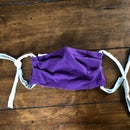Introduction: Compact DIY Travel Pillow
Sleeping in the car or on a plane can be one of the most painful parts of travelling. Common travel pillows are bulky and don't give proper support.
After lots of testing, I've found a pillow design that's super comfortable and easy to travel with. This "pillow" is easily compactable and fully supports your head and shoulders no matter what situation you're in. It includes an inflatable cushion and even an "arm hammock" for added support that also keeps your arms from getting cold.
Step 1: Gather Materials
Base and hinges
Thin but sturdy material that can still be cut. I used a binder.
Exacto knife
Duct tape
Hot glue
Strip of magnet tape (This is optional, but I think it vastly improved stability)
Protractor
Pillow
Small inflatable cushion (I used a swim floatie)
Similarly sized sheet of fabric
Arm hammock
Approx. 18" x18" square of fabric
Needle and thread
Straps
Nylon or elastic straps (see the photo as a reference)
Sturdy buckles
Step 2: Cutting the Base
First, if using a binder, remove the metal bar by cutting around the brads.
Use an exacto knife to cut the binder into three rectangular boards. I found the ideal size about 6" by 8" and used a paper template that I cut.
I ended up running out of material to make another complete board. If that happens to you, you can attach multiple pieces of material with white or hot glue to form a complete board.
Step 3: Making the Hinges
I found the optimal angle around 130º. Using that measurement, I cut out six triangles and attached them in groups of 3 with hot glue and duct tape.
If they look ugly like mine did, that's ok. The glue and tape can be used to smooth out the edges a bit.
Step 4: Add the Hinges
Duct tape all three sections so they can fold onto each other, accordion style. Also, smooth out and duct tape any rough edges.
To securely attach the hinges, outline them and cut out two rectangular holes that they can snugly fit into, as shown in photos 2 nd 3.
Then, duct tape the hinges to the sides of the middle section, as seen in photo 4. Align the angle of the hinge to where the two boards meet. Make sure to duct tape the hinges loosely so they can be folded in and behind the boards.
And finally, hot glue the magnet tape to the hinge and inside of the rectangular holes, as shown in the last photo. This will make the hinge even more secure.
Step 5: Preparing the Straps
I found that a 4 foot-long strap could securely fasten me to a large car seat, so I cut two 4-foot lengths. This seems like a good general length.
Loop one end of the strap through the female side of the buckle, and stitch to secure it, as shown in photos 2 and 3.
Feed the other end of the strap through the male section of the buckle, as shown in photos 4 and 5. Finally, fold over the last inch or so of the strap and sew, as shown in photo 5.
To tighten, simply pull on the strap that sticks out. This is almost exactly like tightening an airplane seatbelt.
Step 6: Attaching the Straps
To keep the straps close to the board, use four smaller pieces of elastic as loops that the straps can be fed through. These pieces should be on the same side of the board as the hinges. I simply used hot glue to secure the elastic loops where I wanted. After some experimentation, I found that the best places to attach were on the bottom board as well as directly on the hinges, as shown in the first picture.
After you're done, feed the straps through each of these loops.
Step 7: Arm Hammock
Fold the square piece of fabric in half and sew the top edge so it forms a sort of tube. To make it look prettier, fold it inside out after sewing.
Then, lay it between the two straps and hot glue the top edge. to the board
Step 8: Cushions
Lay the pool cushion on top of a similarly-shaped piece of fabric and hot glue the excess.
I had the annoying nozzle in the middle of my floatie, which made it poke when leaning on it and kept the boards from cleanly folding during storage. To accommodate it, I cut various holes in the boards so the nozzle could fit, as shown in photos 4 and 5. The holes also helped keep the pillow in place as shown in photo 6, which is why I didn't use any other mechanism to secure it to the board.
Step 9: Assembly
To use: fold the hinges so they tuck into their specific holes. Make sure the magnets line up. Inflate the pillow and place the nozzle back in its hole.
Wrap the straps around the back of your chair, tightening as necessary.
Then, lean forward, put your arms in the hammock, and enjoy a comfortable nap.
Step 10: Packing It Up
Packing it up is easy, too.
Fold back the hinges and scrunch up the straps/arm hammock. Deflate the pillow and fold everything up in a
z-shape as shown.
Tuck in any remaining straps that are sticking out and put the cushion back in place.

Participated in the
Invention Challenge 2017

Participated in the
#Vanlife Contest

Participated in the
Travel Contest 2017











